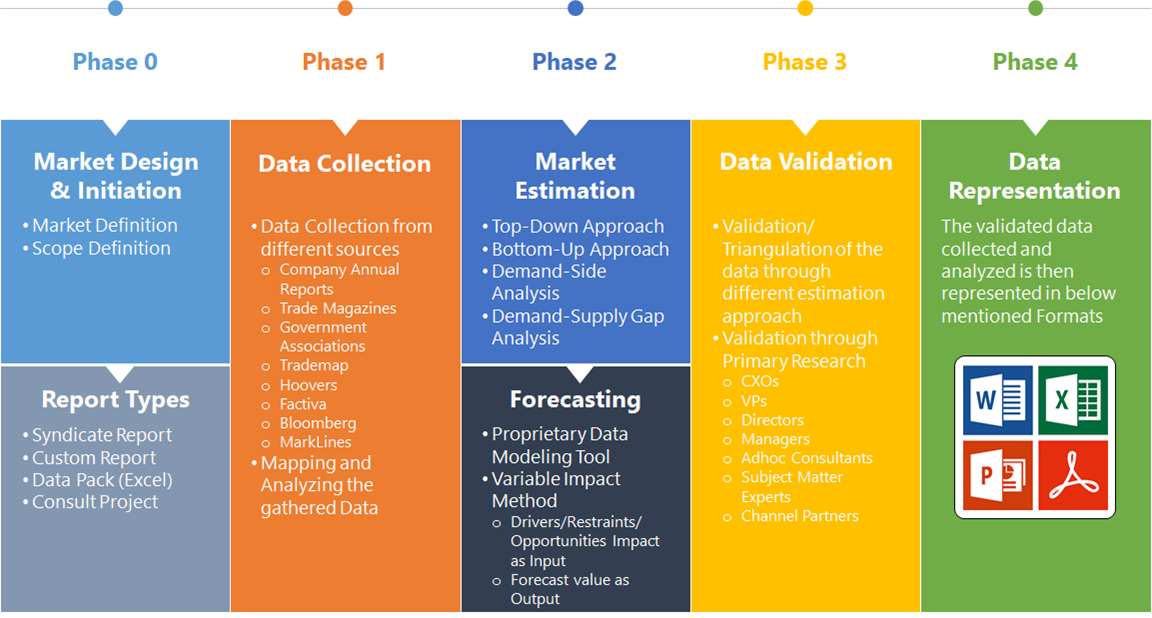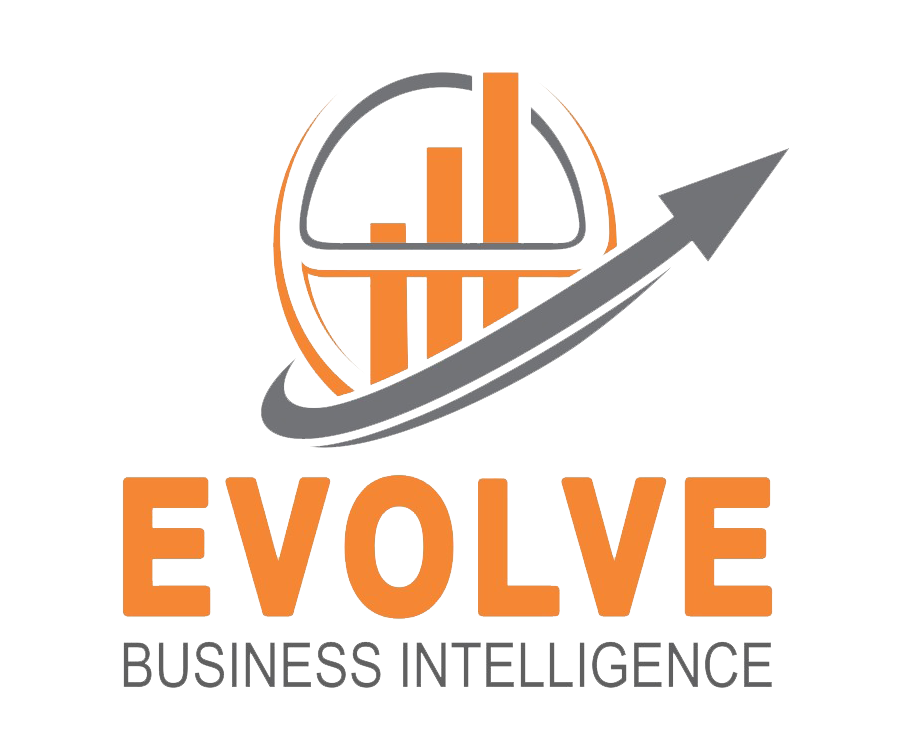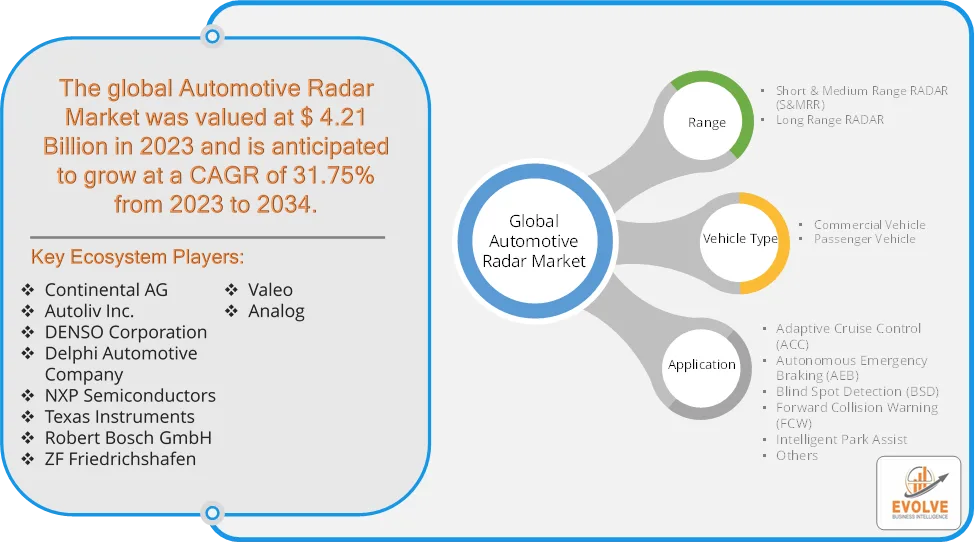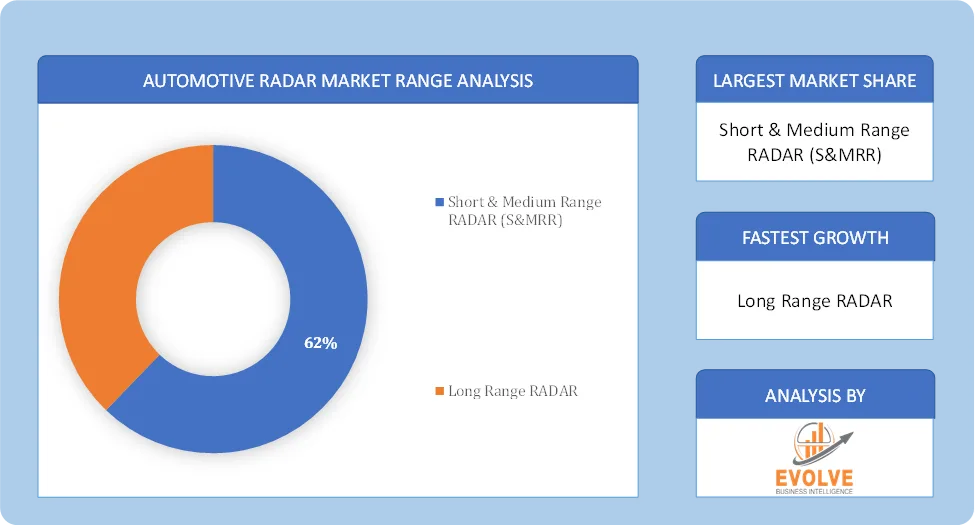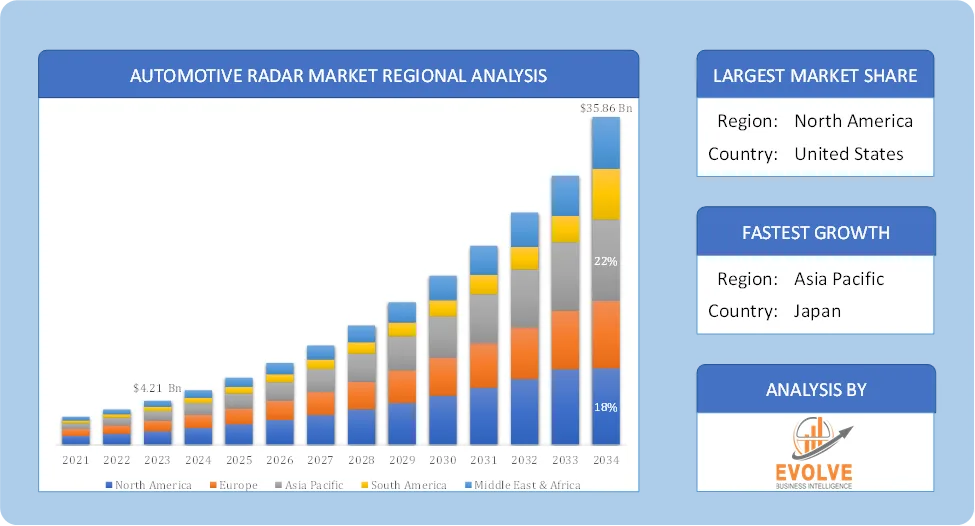Automotive Radar Market Analysis and Global Forecast 2024-2034
$ 1,390.00 – $ 5,520.00Price range: $ 1,390.00 through $ 5,520.00
Automotive Radar Market Research Report: Information By Range (Short & Medium Range RADAR (S&MRR), Long Range RADAR), By Vehicle Type (Commercial Vehicle, Passenger Vehicle), Application (Adaptive Cruise Control (ACC), Autonomous Emergency Braking (AEB), Blind Spot Detection (BSD), Forward Collision Warning (FCW), Intelligent Park Assist, Others), and by Region — Forecast till 2034
Page: 165
Automotive Radar Market Overview
The Automotive Radar Market size accounted for USD 4.21 Billion in 2023 and is estimated to account for 6.87 Billion in 2024. The Market is expected to reach USD 35.86 Billion by 2034 growing at a compound annual growth rate (CAGR) of 31.75% from 2024 to 2034. The Automotive Radar Market is a rapidly growing segment within the automotive industry, driven by the increasing adoption of Advanced Driver Assistance Systems (ADAS) and autonomous driving technologies. Radar sensors are essential for detecting objects, measuring distances, and ensuring vehicle safety in various driving conditions.
The Automotive Radar Market is expected to witness strong growth due to the increasing penetration of ADAS in mid-range and budget cars, the push for autonomous driving, and continuous advancements in radar technology.
Global Automotive Radar Market Synopsis
 Automotive Radar Market Dynamics
Automotive Radar Market Dynamics
The major factors that have impacted the growth of Automotive Radar Market are as follows:
Drivers:
Ø Growing Adoption of Advanced Driver Assistance Systems (ADAS)
Increasing demand for ADAS features such as Adaptive Cruise Control (ACC), Blind Spot Detection (BSD), Automatic Emergency Braking (AEB), and Lane Departure Warning (LDW). Automotive radar is a crucial sensor for these safety systems, enabling precise object detection and collision prevention. Autonomous driving technology relies heavily on radar sensors for object detection, lane-keeping, and environmental mapping. The transition from Level 2 (Partial Automation) to Level 3 and above (Conditional/High Automation) is accelerating radar adoption. EV manufacturers are integrating radar-based ADAS features to enhance driver assistance and autonomous capabilities and growing adoption of smart and connected vehicles further boosts the need for radar sensors in EVs.
Restraint:
- Complex Sensor Fusion & Data Processing
Radar sensors must work alongside LiDAR, cameras, and ultrasonic sensors for autonomous driving. The fusion of multiple sensor data requires advanced computing power, which adds complexity and cost. Radar systems in connected and autonomous vehicles are vulnerable to hacking and cyber threats. Signal jamming and spoofing attacks can interfere with radar-based ADAS functions and ensuring secure data transmission increases R&D and operational costs.
Opportunity:
⮚ Advancements in Radar Technology
4D imaging radar provides superior object detection, range, and accuracy, even in poor weather conditions. Integration of AI and machine learning enhances radar’s ability to differentiate between objects (pedestrians, vehicles, cyclists) and Solid-state radar and multi-mode radar developments improve performance and reduce costs. EV adoption is surging, and manufacturers are equipping these vehicles with radar-driven safety features. Tesla, Rivian, Lucid Motors, and traditional automakers are integrating advanced radar sensors for collision avoidance, adaptive cruise, and smart autopilot systems and governments worldwide are pushing for EV safety standards, which will drive the need for radar-based ADAS solutions.
Automotive Radar Market Segment Overview
Based on Range, the market is segmented based on Short & Medium Range RADAR (S&MRR), Long Range RADAR. Medium and short range segment dominant the market. due to their critical role in enabling various safety and driver assistance features. These radar systems are extensively used for applications such as blind-spot detection, lane change assist, parking assistance, and rear cross-traffic alert, addressing the immediate surroundings of a vehicle with precision. Their ability to detect objects and obstacles at close ranges makes them essential for navigating urban traffic and tight parking scenarios, where immediate hazard recognition is crucial.
By Vehicle Type
Based on Vehicle Type, the market segment has been divided into Commercial Vehicle and Passenger Vehicle. Passenger cars segment dominant the market. Passenger cars are widely employed because of the increasing adoption of advanced safety systems and driver assistance technologies.
By Application
Based on Application, the market segment has been divided into Adaptive Cruise Control (ACC), Autonomous Emergency Braking (AEB), Blind Spot Detection (BSD), Forward Collision Warning (FCW), Intelligent Park Assist, Others. Adaptive cruise control (ACC) segment dominant the market. Due to its critical role in enhancing vehicle safety and driving comfort. The increasing emphasis on ADAS is elevating the adoption of ACC, as it enables vehicles to automatically adjust their speed to maintain safe distances from other vehicles. Regulatory mandates promoting collision avoidance systems and advanced safety features further support its widespread implementation. ACC’s ability to function effectively in various traffic conditions, combined with advancements in radar technology, has made it a preferred choice for manufacturers.
Global Automotive Radar Market Regional Analysis
Based on region, the global Automotive Radar Market has been divided into North America, Europe, Asia-Pacific, the Middle East & Africa, and Latin America. North America is projected to dominate the use of the Automotive Radar Market followed by the Asia-Pacific and Europe regions.
 North America Automotive Radar Market
North America Automotive Radar Market
North America holds a dominant position in the Automotive Radar Market. The United States is a leading market, driven by strong demand for advanced safety features and the presence of major automotive technology companies. Investments in autonomous driving and the development of advanced ADAS are fueling market growth and Government initiatives and regulations focused on vehicle safety are also playing a significant role.
Asia-Pacific Automotive Radar Market
The Asia-Pacific region has indeed emerged as the fastest-growing market for the Automotive Radar Market industry. Countries like China, Japan, and India are experiencing significant increases in automotive production and demand for ADAS technologies. China, in particular, is heavily investing in autonomous driving, leading to a surge in radar system adoption and increasing urbanization and rising disposable incomes are also contributing to the demand for safer vehicles in this region.
Competitive Landscape
The global Automotive Radar Market is highly competitive, with numerous players offering a wide range of software solutions. The competitive landscape is characterized by the presence of established companies, as well as emerging startups and niche players. To increase their market position and attract a wide consumer base, the businesses are employing various strategies, such as product launches, and strategic alliances.
Prominent Players:
- Continental AG
- Autoliv Inc.
- DENSO Corporation
- Delphi Automotive Company
- NXP Semiconductors
- Texas Instruments
- Robert Bosch GmbH
- ZF Friedrichshafen
- Valeo
Key Development
In September 2023, Mercedes-Benz introduced Drive Pilot in the U.S., featuring Level 3 autonomous technology. With a strong emphasis on safety, Drive Pilot integrates advanced features such as a rear camera, LiDAR, a road wetness sensor, and microphones designed to detect emergency vehicles.
In January 2023, Continental, a technology corporation, partnered with Ambarella, Inc., a semiconductor company focused on edge AI. This collaboration aims to create scalable, end-to-end AI-driven software and hardware solutions for automated driving systems.
Scope of the Report
Global Automotive Radar Market, by Range
- Short & Medium Range RADAR (S&MRR)
- Long Range RADAR
Global Automotive Radar Market, by Vehicle Type
- Commercial Vehicle
- Passenger Vehicle
Global Automotive Radar Market, by Application
- Adaptive Cruise Control (ACC)
- Autonomous Emergency Braking (AEB)
- Blind Spot Detection (BSD)
- Forward Collision Warning (FCW)
- Intelligent Park Assist
- Others
Global Automotive Radar Market, by Region
- North America
- US
- Canada
- Mexico
- Europe
- UK
- Germany
- France
- Italy
- Spain
- Benelux
- Nordic
- Rest of Europe
- Asia Pacific
- China
- Japan
- South Korea
- Indonesia
- Austalia
- Malaysia
- India
- Rest of Asia Pacific
- South America
- Brazil
- Argentina
- Rest of South America
- Middle East & Africa
- Saudi Arabia
- UAE
- Egypt
- South Africa
- Rest of Middle East & Africa
| Parameters | Indicators |
|---|---|
| Market Size | 2034: USD 35.86 Billion |
| CAGR (2024-2034) | 31.75% |
| Base year | 2022 |
| Forecast Period | 2024-2034 |
| Historical Data | 2021 (2017 to 2020 On Demand) |
| Report Coverage | Revenue Forecast, Competitive Landscape, Growth Factors, and Trends |
| Key Segmentations | Range, Vehicle Type, Application |
| Geographies Covered | North America, Europe, Asia-Pacific, South America, Middle East, Africa |
| Key Vendors | Continental AG, Autoliv Inc., DENSO Corporation, Delphi Automotive Company, NXP Semiconductors, Texas Instruments, Robert Bosch GmbH, ZF Friedrichshafen, Valeo and Analog. |
| Key Market Opportunities | · Advancements in Radar Technology
· Expansion of Electric Vehicles (EVs) with Radar-Based ADAS |
| Key Market Drivers | · Growing Adoption of Advanced Driver Assistance Systems (ADAS)
· Increasing Demand for Autonomous and Semi-Autonomous Vehicles |
REPORT CONTENT BRIEF:
- High-level analysis of the current and future Automotive Radar Market trends and opportunities
- Detailed analysis of current market drivers, restraining factors, and opportunities in the future
- Automotive Radar Market historical market size for the year 2021, and forecast from 2023 to 2033
- Automotive Radar Market share analysis at each product level
- Competitor analysis with detailed insight into its product segment, Government & Defense strength, and strategies adopted.
- Identifies key strategies adopted including product launches and developments, mergers and acquisitions, joint ventures, collaborations, and partnerships as well as funding taken and investment done, among others.
- To identify and understand the various factors involved in the global Automotive Radar Market affected by the pandemic
- To provide a detailed insight into the major companies operating in the market. The profiling will include the Government & Defense health of the company’s past 2-3 years with segmental and regional revenue breakup, product offering, recent developments, SWOT analysis, and key strategies.
Frequently Asked Questions (FAQ)
What is the study period of this market?
The study period of the global Automotive Radar Market is 2021- 2033
What is the growth rate of the global Automotive Radar Market?
The global Automotive Radar Market is growing at a CAGR of 31.75% over the next 10 years
Which region has the highest growth rate in the market of Automotive Radar Market?
Asia Pacific is expected to register the highest CAGR during 2024-2034
Which region has the largest share of the global Automotive Radar Market?
North America holds the largest share in 2022
Who are the key players in the global Automotive Radar Market?
Continental AG, Autoliv Inc., DENSO Corporation, Delphi Automotive Company, NXP Semiconductors, Texas Instruments, Robert Bosch GmbH, ZF Friedrichshafen, Valeo and Analog. are the major companies operating in the market.
Do you offer Post Sale Support?
Yes, we offer 16 hours of analyst support to solve the queries
Do you sell particular sections of a report?
Yes, we provide regional as well as country-level reports. Other than this we also provide a sectional report. Please get in contact with our sales representatives.
Press Release

Global Pharmaceutical Manufacturing Market to Reach $1.38 Trillion by 2035 with 7.35% CAGR, New Research Shows

The Global Mammography Market Is Estimated To Record a CAGR of Around 10.29% During The Forecast Period

Glue Stick Market to Reach USD 2.35 Billion by 2034

Podiatry Service Market to Reach USD 11.88 Billion by 2034

Microfluidics Technology Market to Reach USD 32.58 Billion by 2034

Ferric Chloride Market to Reach USD 10.65 Billion by 2034

Family Practice EMR Software Market to Reach USD 21.52 Billion by 2034

Electric Hairbrush Market to Reach USD 15.95 Billion by 2034

Daily Bamboo Products Market to Reach USD 143.52 Billion by 2034

Cross-border E-commerce Logistics Market to Reach USD 112.65 Billion by 2034
Table of Content
CHAPTER 1. Executive Summary
CHAPTER 2. Scope of the Study
2.1. Market Definition
2.2. Market Scope & Segmentation
2.2.1. Objective of Report
CHAPTER 3. Evolve BI Methodology
3.1. Data Collection & Validation Approach
3.2. Market Size Estimation and Forecast
CHAPTER 4. Exclusive Analysis
4.1. Market Opportunity Score
4.1.1. Range Segement – Market Opportunity Score
4.1.2. Vehicle Type Segment – Market Opportunity Score
4.1.3. Application Segment – Market Opportunity Score
4.2. Key Market Influencing Indicators
CHAPTER 5. Market Insights and Trends
5.1. Value Chain Analysis
5.1.1. Raw Material
5.1.2. Manufacturing Process
5.1.3. Distribution Channel
5.1.4. End User
5.2. Porter’s Five Forces Analysis
5.2.1. Bargaining Power of Buyers
5.2.2. Bargaining Power of Suppliers
5.2.3. Threat of New Entrant
5.2.4. Threat of Substitute
5.2.5. Industry Rivalry
5.3. COVID-19 Impact and Post COVID Scenario on Automotive Radar Market
5.3.1. Impact of COVID-19
5.3.2. Government Support and Industry Revival Policies
5.3.3. Measures Taken by Companies to Mitigate Negative Impact
5.3.4. Post COVID Trend
CHAPTER 6. Market Dynamics
6.1. Introduction
6.2. Drivers
6.2.1. Driver 1
6.2.2. Driver 2
6.2.3. Driver 3
6.3. Restraints
6.3.1. Restraint 1
6.3.2. Restraint 2
6.4. Opportunity
6.4.1. Opportunity 1
CHAPTER 7. Automotive Radar Market, By Range
7.1. Introduction
7.1.1. Short & Medium Range RADAR (S&MRR)
7.1.2 Long Range RADAR
CHAPTER 8 Automotive Radar Market, By Vehicle Type
8.1. Introduction
8.1.1. Commercial Vehicle
8.1.2. Passenger Vehicle
CHAPTER 9. Automotive Radar Market, By Application
9.1. Introduction
9.1.1. Adaptive Cruise Control (ACC)
9.1.2. Autonomous Emergency Braking (AEB)
9.1.3. Blind Spot Detection (BSD)
9.1.4. Forward Collision Warning (FCW)
9.1.5. Intelligent Park Assist
9.1.6. Others
CHAPTER 10. Automotive Radar Market, By Region
10.1. Introduction
10.2. NORTH AMERICA
10.2.1. North America: Market Size and Forecast, By Country, 2024 – 2034($ Million)
10.2.2. North America: Market Size and Forecast, By Range, 2024 – 2034($ Million)
10.2.3. North America: Market Size and Forecast, By Vehicle Type, 2024 – 2034($ Million)
10.2.4. North America: Market Size and Forecast, By Application, 2024 – 2034($ Million)
10.2.5. US
10.2.5.1. US: Market Size and Forecast, By Range, 2024 – 2034($ Million)
10.2.5.2. US: Market Size and Forecast, By Vehicle Type, 2024 – 2034($ Million)
10.2.5.3. US: Market Size and Forecast, By Application, 2024 – 2034($ Million)
10.2.6. CANADA
10.2.6.1. Canada: Market Size and Forecast, By Range, 2024 – 2034($ Million)
10.2.6.2. Canada: Market Size and Forecast, By Vehicle Type, 2024 – 2034($ Million)
10.2.6.3. Canada: Market Size and Forecast, By Application, 2024 – 2034($ Million)
10.2.7. MEXICO
10.2.7.1. Mexico: Market Size and Forecast, By Range, 2024 – 2034($ Million)
10.2.7.2. Mexico: Market Size and Forecast, By Vehicle Type, 2024 – 2034($ Million)
10.2.7.3. Mexico: Market Size and Forecast, By Application, 2024 – 2034($ Million)
10.3. Europe
10.3.1. Europe: Market Size and Forecast, By Country, 2024 – 2034($ Million)
10.3.2. Europe: Market Size and Forecast, By Range, 2024 – 2034($ Million)
10.3.3. Europe: Market Size and Forecast, By Vehicle Type, 2024 – 2034($ Million)
10.3.4. Europe: Market Size and Forecast, By Application, 2024 – 2034($ Million)
10.3.5. U.K.
10.3.5.1. U.K.: Market Size and Forecast, By Range, 2024 – 2034($ Million)
10.3.5.2. U.K.: Market Size and Forecast, By Vehicle Type, 2024 – 2034($ Million)
10.3.5.3. U.K.: Market Size and Forecast, By Application, 2024 – 2034($ Million)
10.3.6. GERMANY
10.3.6.1. Germany: Market Size and Forecast, By Range, 2024 – 2034($ Million)
10.3.6.2. Germany: Market Size and Forecast, By Vehicle Type, 2024 – 2034($ Million)
10.3.6.3. Germany: Market Size and Forecast, By Application, 2024 – 2034($ Million)
10.3.7. FRANCE
10.3.7.1. France: Market Size and Forecast, By Range, 2024 – 2034($ Million)
10.3.7.2. France: Market Size and Forecast, By Vehicle Type, 2024 – 2034($ Million)
10.3.7.3. France: Market Size and Forecast, By Application, 2024 – 2034($ Million)
10.3.8. ITALY
10.3.8.1. Italy: Market Size and Forecast, By Range 2024 – 2034($ Million)
10.3.8.2. Italy: Market Size and Forecast, By Vehicle Type, 2024 – 2034($ Million)
10.3.8.3. Italy: Market Size and Forecast, By Application, 2024 – 2034($ Million)
10.3.9. SPAIN
10.3.9.1. Spain: Market Size and Forecast, By Range, 2024 – 2034($ Million)
10.3.9.2. Spain: Market Size and Forecast, By Vehicle Type, 2024 – 2034($ Million)
10.3.9.3. Spain: Market Size and Forecast, By Application, 2024 – 2034($ Million)
10.3.10. BENELUX
10.3.10.1. BeNeLux: Market Size and Forecast, By Range, 2024 – 2034($ Million)
10.3.10.2. BeNeLux: Market Size and Forecast, By Vehicle Type, 2024 – 2034($ Million)
10.3.10.3. BeNeLux: Market Size and Forecast, By Application, 2024 – 2034($ Million)
10.3.11. RUSSIA
10.3.11.1. Russia: Market Size and Forecast, By Range, 2024 – 2034($ Million)
10.3.11.2. Russia: Market Size and Forecast, By Vehicle Type, 2024 – 2034($ Million)
10.3.11.3. Russia: Market Size and Forecast, By Application, 2024 – 2034($ Million)
10.3.12. REST OF EUROPE
10.3.12.1. Rest of Europe: Market Size and Forecast, By Range, 2024 – 2034($ Million)
10.3.12.2. Rest of Europe: Market Size and Forecast, By Source, 2024 – 2034($ Million)
10.3.12.3. Rest of Europe: Market Size and Forecast, By Application, 2024 – 2034($ Million)
10.4. Asia Pacific
10.4.1. Asia Pacific: Market Size and Forecast, By Country, 2024 – 2034($ Million)
10.4.2. Asia Pacific: Market Size and Forecast, By Range, 2024 – 2034($ Million)
10.4.3. Asia Pacific: Market Size and Forecast, By Vehicle Type, 2024 – 2034($ Million)
10.4.4. Asia Pacific: Market Size and Forecast, By Application, 2024 – 2034($ Million)
10.4.5. CHINA
10.4.5.1. China: Market Size and Forecast, By Range, 2024 – 2034($ Million)
10.4.5.2. China: Market Size and Forecast, By Vehicle Type, 2024 – 2034($ Million)
10.4.5.3. China: Market Size and Forecast, By Application, 2024 – 2034($ Million)
10.4.6. JAPAN
10.4.6.1. Japan: Market Size and Forecast, By Range, 2024 – 2034($ Million)
10.4.6.2. Japan: Market Size and Forecast, By Vehicle Type, 2024 – 2034($ Million)
10.4.6.3. Japan: Market Size and Forecast, By Application, 2024 – 2034($ Million)
10.4.7. INDIA
10.4.7.1. India: Market Size and Forecast, By Range, 2024 – 2034($ Million)
10.4.7.2. India: Market Size and Forecast, By Vehicle Type, 2024 – 2034($ Million)
10.4.7.3. India: Market Size and Forecast, By Application, 2024 – 2034($ Million)
10.4.8. SOUTH KOREA
10.4.8.1. South Korea: Market Size and Forecast, By Range, 2024 – 2034($ Million)
10.4.8.2. South Korea: Market Size and Forecast, By Vehicle Type, 2024 – 2034($ Million)
10.4.8.3. South Korea: Market Size and Forecast, By Application, 2024 – 2034($ Million)
10.4.9. THAILAND
10.4.9.1. Thailand: Market Size and Forecast, By Range, 2024 – 2034($ Million)
10.4.9.2. Thailand: Market Size and Forecast, By Vehicle Type, 2024 – 2034($ Million)
10.4.9.3. Thailand: Market Size and Forecast, By Application, 2024 – 2034($ Million)
10.4.10. INDONESIA
10.4.10.1. Indonesia: Market Size and Forecast, By Range, 2024 – 2034($ Million)
10.4.10.2. Indonesia: Market Size and Forecast, By Vehicle Type, 2024 – 2034($ Million)
10.4.10.3. Indonesia: Market Size and Forecast, By Application, 2024 – 2034($ Million)
10.4.11. MALAYSIA
10.4.11.1. Malaysia: Market Size and Forecast, By Range, 2024 – 2034($ Million)
10.4.11.2. Malaysia: Market Size and Forecast, By Vehicle Type, 2024 – 2034($ Million)
10.4.11.3. Malaysia: Market Size and Forecast, By Application, 2024 – 2034($ Million)
10.4.12. AUSTRALIA
10.4.12.1. Australia: Market Size and Forecast, By Range, 2024 – 2034($ Million)
10.4.12.2. Australia: Market Size and Forecast, By Vehicle Type, 2024 – 2034($ Million)
10.4.12.3. Australia: Market Size and Forecast, By Application, 2024 – 2034($ Million)
10.4.13. REST FO ASIA PACIFIC
10.4.13.1. Rest fo Asia Pacific: Market Size and Forecast, By Range, 2024 – 2034($ Million)
10.4.13.2. Rest fo Asia Pacific: Market Size and Forecast, By Vehicle Type, 2024 – 2034($ Million)
10.4.13.3. Rest fo Asia Pacific: Market Size and Forecast, By Application, 2024 – 2034($ Million)
10.5. South America
10.5.1. South America: Market Size and Forecast, By Country, 2024 – 2034($ Million)
10.5.2. South America: Market Size and Forecast, By Range, 2024 – 2034($ Million)
10.5.3. South America: Market Size and Forecast, By System, 2024 – 2034($ Million)
10.5.4. South America: Market Size and Forecast, By Application, 2024 – 2034($ Million)
10.5.5. BRAZIL
10.5.5.1. Brazil: Market Size and Forecast, By Range, 2024 – 2034($ Million)
10.5.5.2. Brazil: Market Size and Forecast, By Vehicle Type, 2024 – 2034($ Million)
10.5.5.3. Brazil: Market Size and Forecast, By Application, 2024 – 2034($ Million)
10.5.6. ARGENTINA
10.5.6.1. Argentina: Market Size and Forecast, By Range, 2024 – 2034($ Million)
10.5.6.2. Argentina: Market Size and Forecast, By Vehicle Type, 2024 – 2034($ Million)
10.5.6.3. Argentina: Market Size and Forecast, By Application, 2024 – 2034($ Million)
10.5.7. REST OF SOUTH AMERICA
10.5.7.1. Rest of South America: Market Size and Forecast, By Range, 2024 – 2034($ Million)
10.5.7.2. Rest of South America: Market Size and Forecast, By Vehicle Type, 2024 – 2034($ Million)
10.5.7.3. Rest of South America: Market Size and Forecast, By Application, 2024 – 2034($ Million)
10.6. Middle East & Africa
10.6.1. Middle East & Africa: Market Size and Forecast, By Country, 2024 – 2034($ Million)
10.6.2. Middle East & Africa: Market Size and Forecast, By Range, 2024 – 2034($ Million)
10.6.3. Middle East & Africa: Market Size and Forecast, By Vehicle Type, 2024 – 2034($ Million)
10.6.4. Middle East & Africa: Market Size and Forecast, By Application, 2024 – 2034($ Million)
10.6.5. SAUDI ARABIA
10.6.5.1. Saudi Arabia: Market Size and Forecast, By Range, 2024 – 2034($ Million)
10.6.5.2. Saudi Arabia: Market Size and Forecast, By Vehicle Type, 2024 – 2034($ Million)
10.6.5.3. Saudi Arabia: Market Size and Forecast, By Application, 2024 – 2034($ Million)
10.6.6. UAE
10.6.6.1. UAE: Market Size and Forecast, By Range, 2024 – 2034($ Million)
10.6.6.2. UAE: Market Size and Forecast, By Vehicle Type, 2024 – 2034($ Million)
10.6.6.3. UAE: Market Size and Forecast, By Application, 2024 – 2034($ Million)
10.6.7. EGYPT
10.6.7.1. Egypt: Market Size and Forecast, By Range, 2024 – 2034($ Million)
10.6.7.2. Egypt: Market Size and Forecast, By Vehicle Type, 2024 – 2034($ Million)
10.6.7.3. Egypt: Market Size and Forecast, By Application, 2024 – 2034($ Million)
10.6.8. SOUTH AFRICA
10.6.8.1. South Africa: Market Size and Forecast, By Range, 2024 – 2034($ Million)
10.6.8.2. South Africa: Market Size and Forecast, By Vehicle Type, 2024 – 2034($ Million)
10.6.8.3. South Africa: Market Size and Forecast, By Application, 2024 – 2034($ Million)
10.6.9. REST OF MIDDLE EAST & AFRICA
10.6.9.1. Rest of Middle East & Africa: Market Size and Forecast, By Range, 2024 – 2034($ Million)
10.6.9.2. Rest of Middle East & Africa: Market Size and Forecast, By Vehicle Type, 2024 – 2034($ Million)
10.6.9.3.Rest of Middle East & Africa: Market Size and Forecast, By Application, 2024 – 2034($ Million)
CHAPTER 12. Competitive Landscape
12.1. Competitior Benchmarking 2023-
12.2. Market Share Analysis
12.3. Key Developments Analysis By Top 5 Companies
12.4. Market Share Acquisition Strategies: Analysis of Key Approaches Employed by Top Players
CHAPTER 13. Company Profiles
13.1. Continental AG
13.1.1. Hanon Systems
13.1.2. Financial Analysis
13.1.2.1. Business Segment Revenue, 2020, 2021, 2022, $ Million
13.1.2.2. Geographic Revenue Mix, 2022 (% Share)
13.1.3. Product Portfolio
13.1.4. Recent Development and Strategies Adopted
13.1.5. SWOT Analysis
13.2. Autoliv Inc.
13.3. DENSO Corporation
13.4. Delphi Automotive Company
13.5. NXP Semiconductors
13.6. Texas Instruments
13.7. Robert Bosch GmbH
13.8. ZF Friedrichshafen
13.9 Valeo
13.10 Analog.
Connect to Analyst
Research Methodology
